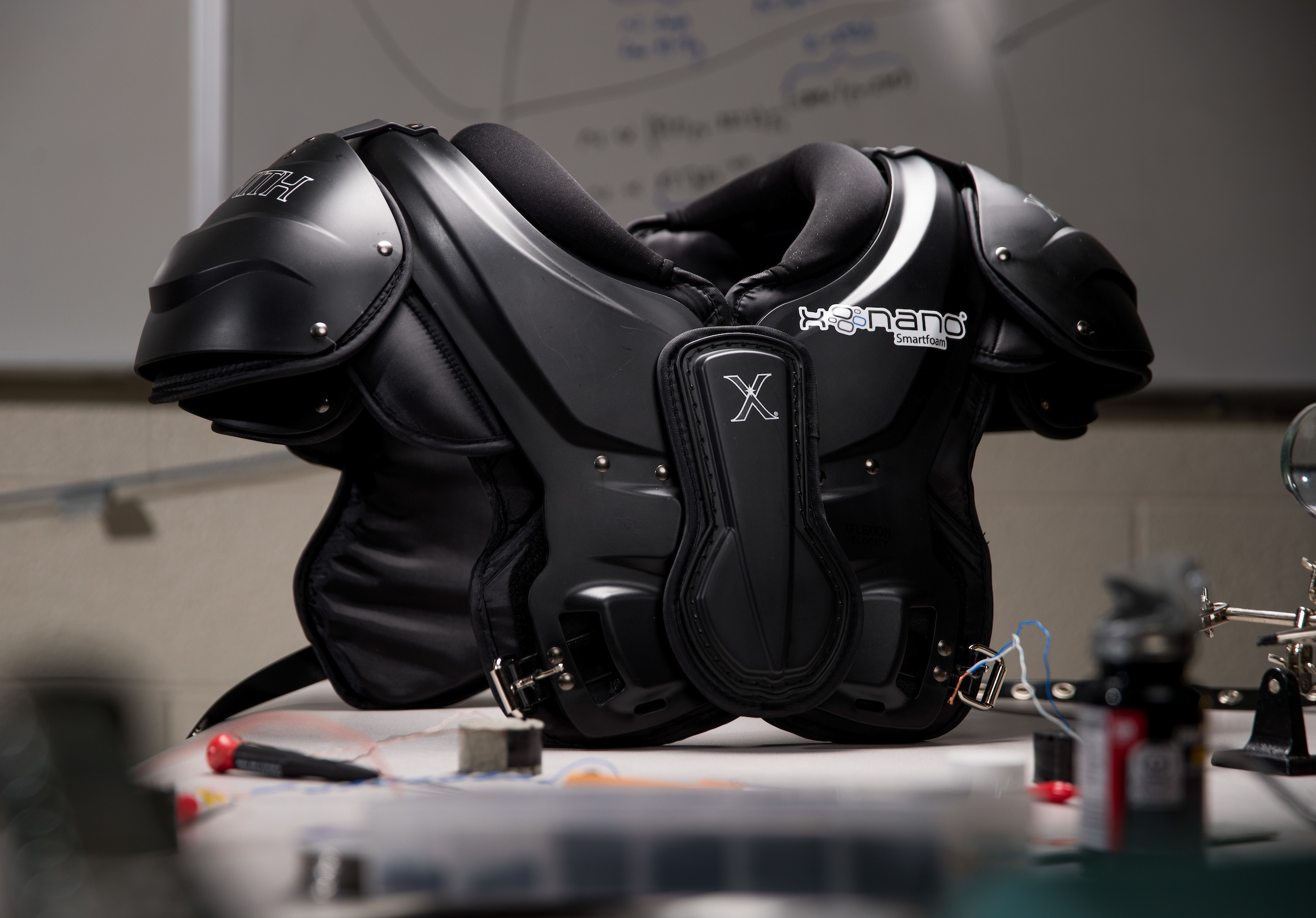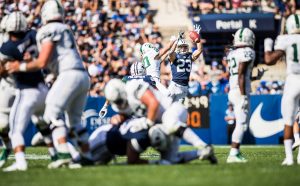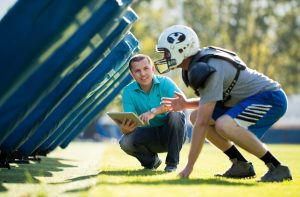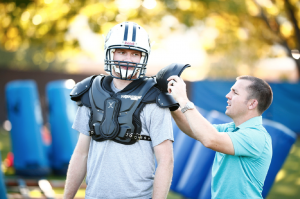
There was nothing different about that game.
The floodlights beamed, the helmets shone; the stands roared with contagious energy. BYU and LSU fought over the ball, their pride and honor on the line. And in the Mercedes-Benz Superdome in New Orleans on Sept. 3, nothing made that football game different than any other for BYU defensive back Zayne Anderson.
Nothing, that is, until he collided head-on with an LSU running back during the first half of the game.
“I just came down,” Anderson, a junior from Stansbury Park, Utah, said. “Me and the running back … were both running full-speed.”

Anderson, however, didn’t notice anything was wrong until a few plays later, when he became confused and, “I didn’t feel like I was there,” he said.
Anderson went into the locker room for about 20 minutes until the effects subsided, sat out the rest of the game and later passed BYU’s concussion protocol before returning to play for the remainder of the season.
Anderson was lucky; his first concussion was brief and didn’t put him out of another game. It also didn’t include a slew of other symptoms such as dizziness, vomiting and emotional volatility. But he still became one of an estimated 1.6-3.8 million Americans who sustain a sports and recreation-related concussion each year, according to the Brain Injury Research Institute.
And despite the number of people who suffer from concussions, “we don’t really know if there’s a shortened life or what the (long-term) effects are,” said BYU Sports Medicine Director Carolyn Billings.
But research from BYU mechanical engineering associate professor Scott Thomson and new technology from BYU mechanical engineering Ph.D. student Jake Merrell could be game-changers both on and off the field. Their work is refining how concussions are studied – and in Merrill’s case, how they’re detected.
Cavitation crisis
Thomson, who teaches courses in fluid mechanics, first connected cavitation to the brain while looking at a succession picture of a glass bottle filled with water. The bottle is hit from the top, but it shatters from the bottom due to an effect called cavitation.

“It’s interesting, because originally when we were looking at this problem, we weren’t talking about brains at all,” he said. “And so as we were studying this with the bottles, we were thinking ‘Well, where else (does this happen)?’”
According to Thomson, cavitation occurs when motion in a liquid (such as a propeller turning) causes the liquid’s pressure to decrease to the point that dissolved gas can form bubbles. Without any pressure to keep them small, those bubbles then expand and move to a region downstream of the fluid, where they collapse rapidly – and often violently.
“There’s this shockwave that gets sent out after the collapse, and that shockwave can cause a lot of damage to any structure in the area,” Thomson said.
The effect can do anything from put pits in propellers to help snapping shrimp stun their prey with a jet-spray of cavitated water. It’s also, Thomson said, linked to concussions and other brain injuries.
While studying cavitation in the glass bottle experiment, he realized “this is different than the propeller case because in this case, you’re starting with a fluid that’s originally at rest and it’s suddenly accelerated,” he said. “And so it’s still cavitation, but it’s two totally different ways that cavitation’s occurring.”
Thomson said this second type of cavitation relates to brain injuries. He also said he’s not the first person to make this connection, but his team realized that knowing cavitation causes the concussion, not the impact itself, could mean better prediction of when concussions will occur.
Thomson joined researchers from Utah State University and the Tokyo University of Agriculture and Technology to create an equation “that predicts when cavitation will occur in a fluid that is suddenly accelerated from rest,” he said. “That’s helpful because you’re (then) able to design whatever needs to be designed in order to try to prevent that from occurring.”
Foam of the future
That’s where Jake Merrell’s technology could come in.
“What we hope is that we’re able to gain better understanding of what causes concussions,” he said. “We hope to… identify concussions better.”
Merrell said he’s a non-traditional student who owned several businesses before selling his excavation company’s equipment in 2007 and returning to school in 2010 at age 27. He began working toward his Ph.D. after creating the material that would become the basis of his company XOnano: a self-sensing, piezoelectric foam they named SmartFoam, according to the XOnano website.
“We started out making these rubberband-like sensors… but they couldn’t measure compression,” Merrell said. “So we tried to implement it into a foam.”
Merrell said the SmartFoam operates under the same base phenomena as rubbing a balloon against hair.

“So electrons move from one material to another, and so just like when you do that on your hair, your hair stands up,” he said. “We do the same thing with the nano-particles that are inside the foam.”
When they put SmartFoam in a football helmet and dropped it from different heights, Merrell’s team was able to measure data such as impact severity, location of impact and velocity – with about 90 percent accuracy, according to Merrell’s research published in the Annals of Biomedical Engineering. The foam can also go into football pads.
“So impact severity is kind of a measure to see if it will cause a concussion or not,” Merrell said. “… We can determine how hard (a football player) has been hit and help determine if there’s some damage to the head.”
While SmartFoam can’t prevent concussions, it could potentially let a doctor on the side of a football field know instantly both that a player has a concussion and how severe it is. This data could then lead to more exact and detailed information about when and how concussions occur.
“(SmartFoam) just gives us information in a system that’s never had it before,” Merrell said.
Merrell said XOnano now has a manufacturer on the east coast making their foam in bulk. They’re currently working with a Taekwondo vest company, and they hope to work with many different manufacturers and products.
While he hasn’t talked directly to Thomson about how cavitation could factor into SmartFoam, “you might be able to draw some correlation from what’s happening to the head externally to what’s happening internally, but that’s beyond the scope of what I’ve studied,” he said.
Using their heads
Since SmartFoam doesn’t actually prevent concussions, will it really make a difference to football players?
“I do (think it will make a difference),” said Billings, from the sports medicine perspective. “I don’t know if it’s going to solve all the problems at once, but I think as we continue to go down that road, it will be very helpful, too.”
Billings said she sees some players hit each other hard without any issues, while some players make barely any contact and walk away with concussions. The SmartFoam could help sort out why.
“If anything, the foam is helpful in recording the amount of things so that we can start to gather this information… as we follow these people on what are the long-term effects and what’s too much and those types of things,” Billings said.

Billings said the biggest things football players can do to prevent concussions are getting good sleep and improving nutrition habits, and developing proper tackling and leading techniques.
“The head was never diagnosed as a weapon, and no one should be teaching that and no one should be practicing that in football,” she said.
Billings said the BYU football team averages about 10 to 15 concussions a season. (NFL players sustained 244 concussions during the 2016 season, according to an NFL report released in Jan. 2017.) Billings said concussion symptoms range from lightheadedness, headaches, nausea and blurred vision to memory loss, forgetfulness, loss of balance and an inability to retain information. The best thing for all those symptoms, she added, is rest, particularly for the brain.
“They shouldn’t be texting on their phone. They should be off social media. They shouldn’t be using the computer. They should go into class and know a Powerpoint presentation in a certain light can keep (the concussion) nagging longer than we’d like,” Billings said.
The need for rest has resulted in BYU’s “return to learn” policy that takes concussed athletes out of class and practice until the sports medicine team decides it’s safe for them to go back, Billings said. But Billings also said deciding when a concussion is healed can be difficult to determine; she’s seen concussions last anywhere from four days to two or three months.
“A lot of it depends on how bad the concussion is,” Billings said, “and then… how they stress, what their anxiety level is… proper nutrition, (all factors into it).”
Anderson, the BYU football player who sustained a concussion during the LSU game, said it’s important to respect an athlete with a concussion.
“Our heads are really important,” he said. “We care about our teammates more than them playing.”
He also agreed with Billings that SmartFoam could make a difference to football players.
“I think less people would lead with their heads,” he said. “Because no one wants to be taken out of the game.”




